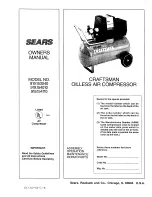
- 11 -
18 The unit has parts, which may be accidentally
touched, of which the temperature can be in
excess of 80 °C (176 °F). The insulation or safety
guard, protecting these parts shall not be removed
before the parts have cooled down to room
temperature. As it is technically not possible to
insulate all hot parts or to install safety guards
around hot parts (e.g. exhaust manifold, exhaust
turbine), the operator / service engineer must
always be aware not to touch hot parts when
opening a machine door.
19 Never operate the unit in surroundings where
there is a possibility of taking in flammable or
toxic fumes.
20 If the working process produces fumes, dust or
vibration hazards, etc., take the necessary steps to
eliminate the risk of personal injury.
21 When using compressed air or inert gas to clean
down equipment, do so with caution and use the
appropriate protection, at least safety glasses, for
the operator as well as for any bystander. Do not
apply compressed air or inert gas to your skin or
direct an air or gas stream at people. Never use it
to clean dirt from your clothes.
22 When washing parts in or with a cleaning solvent,
provide the required ventilation and use
appropriate protection such as a breathing filter,
safety glasses, rubber apron and gloves, etc.
23 Safety shoes should be compulsory in any
workshop and if there is a risk, however small, of
falling objects, wearing of a safety helmet should
be included.
24 If there is a risk of inhaling hazardous gases,
fumes or dust, the respiratory organs must be
protected and depending on the nature of the
hazard, so must the eyes and skin.
25 Remember that where there is visible dust, the
finer, invisible particles will almost certainly be
present too; but the fact that no dust can be seen
is not a reliable indication that dangerous,
invisible dust is not present in the air.
26 Never operate the unit at pressures or speeds
below or in excess of its limits as indicated in the
technical specifications.
27 Do not use aerosol types of starting aids such as
ether. Such use could result in an explosion and
personal injury.
SAFETY DURING MAINTENANCE AND
REPAIR
Maintenance, overhaul and repair work shall only be
carried out by adequately trained personnel; if
required, under supervision of someone qualified for
the job.
1
Use only the correct tools for maintenance and
repair work, and only tools which are in good
condition.
2
Parts shall only be replaced by genuine Atlas
Copco replacement parts.
3
All maintenance work, other than routine
attention, shall only be undertaken when the unit
is stopped. Steps shall be taken to prevent
inadvertent starting. In addition, a warning sign
bearing a legend such as ”work in progress; do
not start” shall be attached to the starting
equipment. On engine-driven units the battery
shall be disconnected and removed or the
terminals covered by insulating caps. On
electrically driven units the main switch shall be
locked in open position and the fuses shall be
taken out. A warning sign bearing a legend such
as ”work in progress; do not supply voltage” shall
be attached to the fuse box or main switch.
4
Before dismantling any pressurized component,
the compressor or equipment shall be effectively
isolated from all sources of pressure and the entire
system shall be relieved of pressure. Do not rely
on non-return valves (check valves) to isolate
pressure systems. In addition, a warning sign
bearing a legend such as ”work in progress; do
not open” shall be attached to each of the outlet
valves.
5
Prior to stripping an engine or other machine or
undertaking major overhaul on it, prevent all
movable parts from rolling over or moving.
6
Make sure that no tools, loose parts or rags are left
in or on the machine. Never leave rags or loose
clothing near the engine air intake.
7
Never use flammable solvents for cleaning (fire-
risk).
8
Take safety precautions against toxic vapours of
cleaning liquids.
9
Never use machine parts as a climbing aid.
10 Observe scrupulous cleanliness during
maintenance and repair. Keep away dirt, cover
the parts and exposed openings with a clean cloth,
paper or tape.
11 Never weld on or perform any operation
involving heat near the fuel or oil systems. Fuel
and oil tanks must be completely purged, e.g. by
steam-cleaning, before carrying out such
operations. Never weld on, or in any way modify,
pressure vessels. Disconnect the alternator cables
during arc welding on the unit.
12 Support the tow bar and the axle(s) securely if
working underneath the unit or when removing a
wheel. Do not rely on jacks.
13 Do not remove any of, or tamper with, the sound-
damping material. Keep the material free of dirt
and liquids such as fuel, oil and cleansing agents.
Summary of Contents for XAHS 447 Cd S3A APP
Page 2: ......
Page 24: ... 24 SH 03 ENGINE CIRCUIT 1 2 3 5 9 8 7 6 G 4 10 A B C D E F 9822 0963 49 ...
Page 25: ... 25 SH 04 CONTROL MODULE 1 2 3 5 9 8 7 6 4 10 A B C D 9822 0963 49 ...
Page 26: ... 26 SH 05 COMPRESSOR CIRCUIT 1 2 3 5 9 8 7 6 G 4 10 A B C D E F 9822 0963 49 ...
Page 27: ... 27 SH 06 OPTIONAL EQUIPMENT 1 2 3 5 9 8 7 6 G 4 10 A B C D E F 9822 0963 49 ...
Page 28: ... 28 SH 07 OPTIONAL EQUIPMENT 1 2 3 5 9 8 7 6 4 10 A B C D E 9822 0963 49 ...
Page 110: ... 110 Notes ...
Page 111: ......
Page 112: ......












































